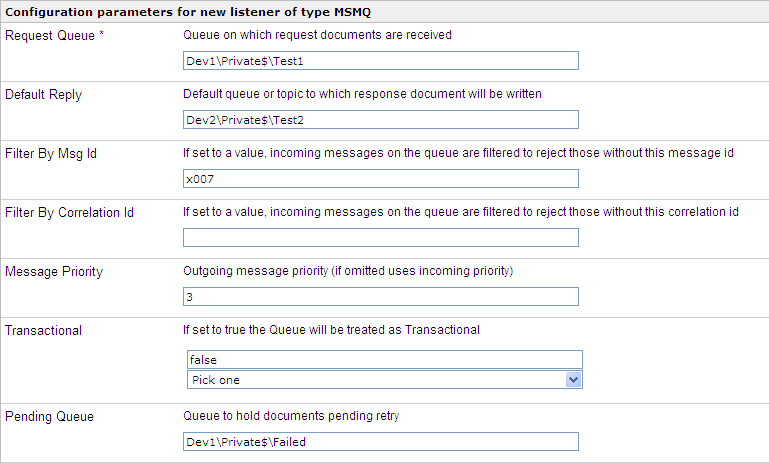|
Request Queue (required)
|
Queue on which request documents
are received. The name is case-sensitive and conforms to the following
format
Host\queuetype$\qName where: - Host
Is the machine name where the Microsoft Queuing system is
running. - queuetype
Private queues are queues that are not published in Active
Directory and appear only on the local computer where they reside.
Private queues are accessible only by Message Queuing applications
that recognize the full path name or format name of the queue. - qName
Is the name of the queue where messages are placed, for example: iwaykxc1\Private$\siebel
|
|
Default Reply
|
Default queue where responses
are directed unless specified otherwise, and where the message is
routed. Conforms to the following format
Host\queuetype$\qName where: - Host
Is the machine name where the Microsoft Queuing system is
running. - queuetype
Private queues are queues that are not published in Active
Directory and appear only on the local computer where they reside.
Private queues are accessible only by Message Queuing applications
that recognize the full path name or format name of the queue. - qName
Name of the queue where messages are placed.
|
|
Filter by Msg Id
|
If values are entered, Service
Manager accepts only messages with this message header value.
|
|
Filter by Correlation Id
|
If values are entered, Service
Manager accepts only messages with this message header value.
|
|
Message Priority
|
Microsoft defines eight levels
of message priority with values 0 through 7, where 0 is the lowest
and 7 is the highest. Zero through three are considered normal settings,
and four through seven, expedited. The Message Priority field is
the default priority value set in the message header.
|
|
Transactional
|
If set to true, the
queue will be treated as transactional.
|
|
Pending Queue
|
Name of the queue where Service
Manager keeps requests that have not been processed (due to the
back-end data server not being available).
|
|
Duration
|
The maximum time, in seconds,
that a document can remain in the Retry pending queue.
|
|
Retry
|
The interval between retrying
pending requests.
|
|
User Headers
|
The include user attributes
in RFH2 header.
|
|
Whitespace Normalization
|
Specifies how the parser treats
whitespace in Element content. Choose preserve to
turn off all normalization as prescribed by the XML Specification.
Choose condense to remove extra whitespace
in pretty printed documents and for compatibility with earlier versions.
|
|
Accepts non-XML
(flat) only
|
Select true if
non-XML input is expected. If enabled, XML input still can be passed
to the listener. Preparsers do not run.
|
|
Optimize Favoring
|
For small documents, select performance.
For large volumes of data, select memory.
|
|
Multithreading
|
The number of worker threads.
Equivalent to the number of document requests the engine can handle
in parallel.
Setting this to a value greater than 1 enables
the listener to handle a second request while an earlier request
is processed. The total throughput of a system can be affected by
the number of threads operating.
Default = 1 Max value = 99
|
|
Execution Time
Limit
|
The maximum time a request
can take to complete. A request that takes longer to complete terminates.
Prevents runaway requests.
|
|
Polling Interval
|
The maximum wait interval between
checks of the MSM queues.
The higher the value, the longer
the interval, and the fewer system resources used. The side effect
of a high value is that the worker thread cannot respond to a stop
command. Default = 2.0
|
|
Default Java File
Encoding
|
The default encoding if incoming
message is not self-declaring (that is, XML).
|
|
Agent Precedence
|
Sets the order for selecting
the Execution Agent. The system selects the agent(s) to use to process
the document by searching through the configuration dictionary.
Usually, it looks for a document entry in the configuration and
when a match is found, the agent specified in that document entry
is selected.
If a matching document entry is not found or
no agent is specified, the engine looks in the input protocol configuration (listener).
For the processing agent to be taken directly from the listener
(thus ignoring the document entry), select Listener Overrides
Document.
An alternative is Document Overrides
Listener. <document> overrides <listener> is the default
value.
|
|
Always reply to
listener default
|
If set to true, the
default reply definition is used in addition to defined destinations.
|
|
Error Documents treated normally
|
If set to true, error
documents are processed by configured preemitters.
|
|
Listener is Transaction Manager
|
If set to true, agents
run in a local transaction. Agents can roll back uncompleted transactions.
|
|
Record in Activity Log(s)
|
If set to true, activity on this
channel will be recorded in the activity logs. If set to false,
the activity will not be recorded.
|

